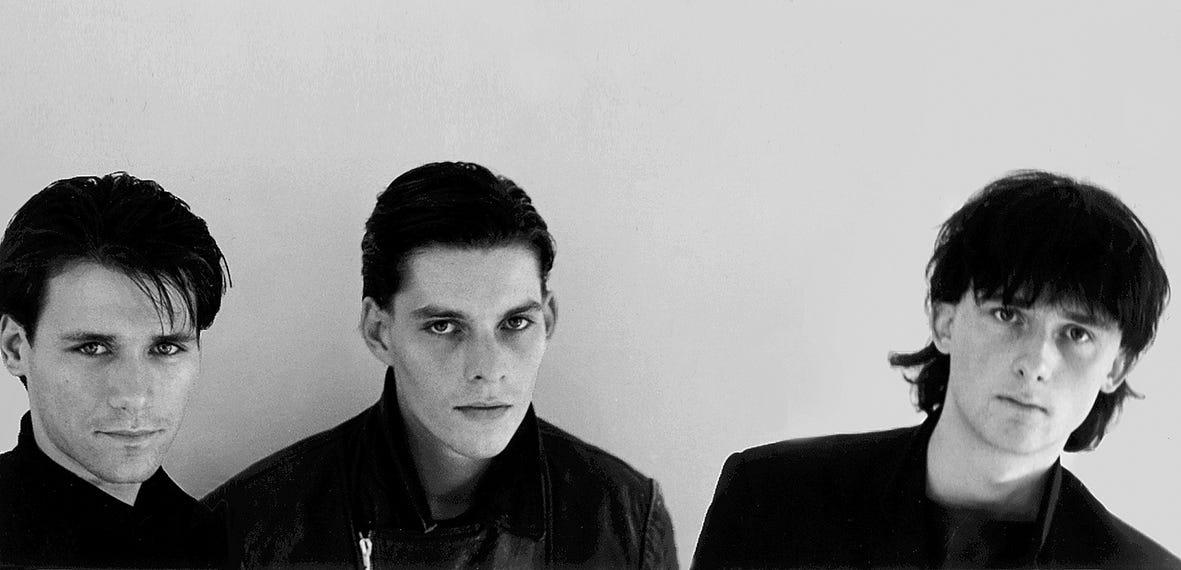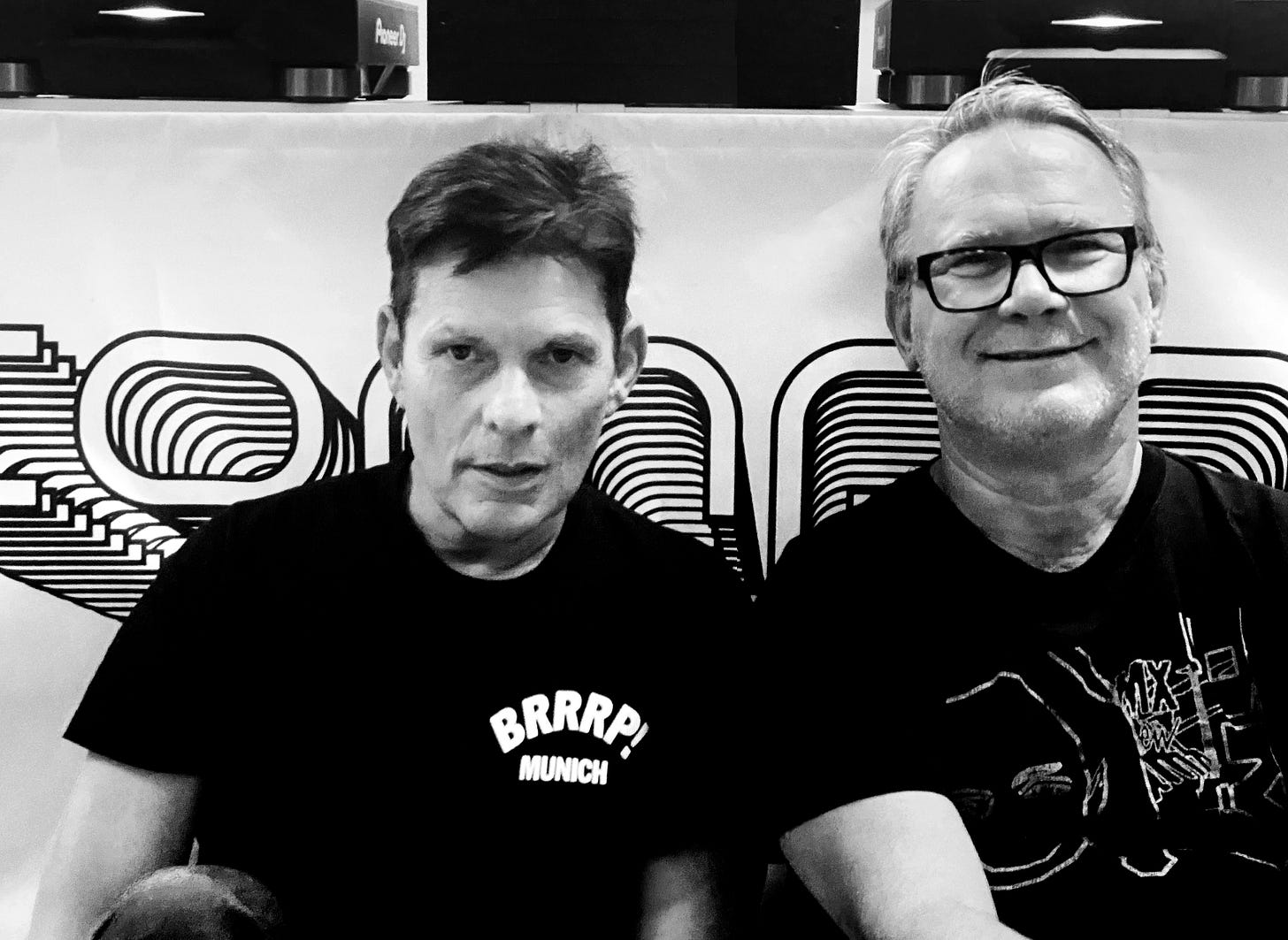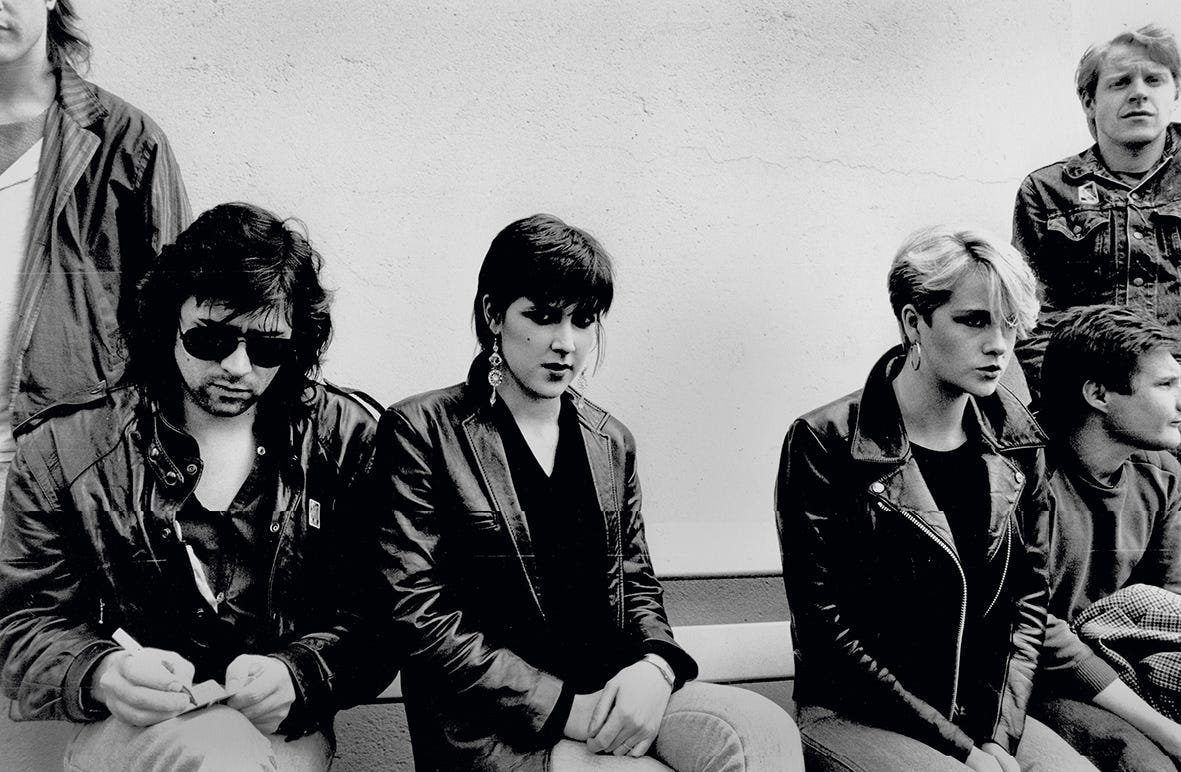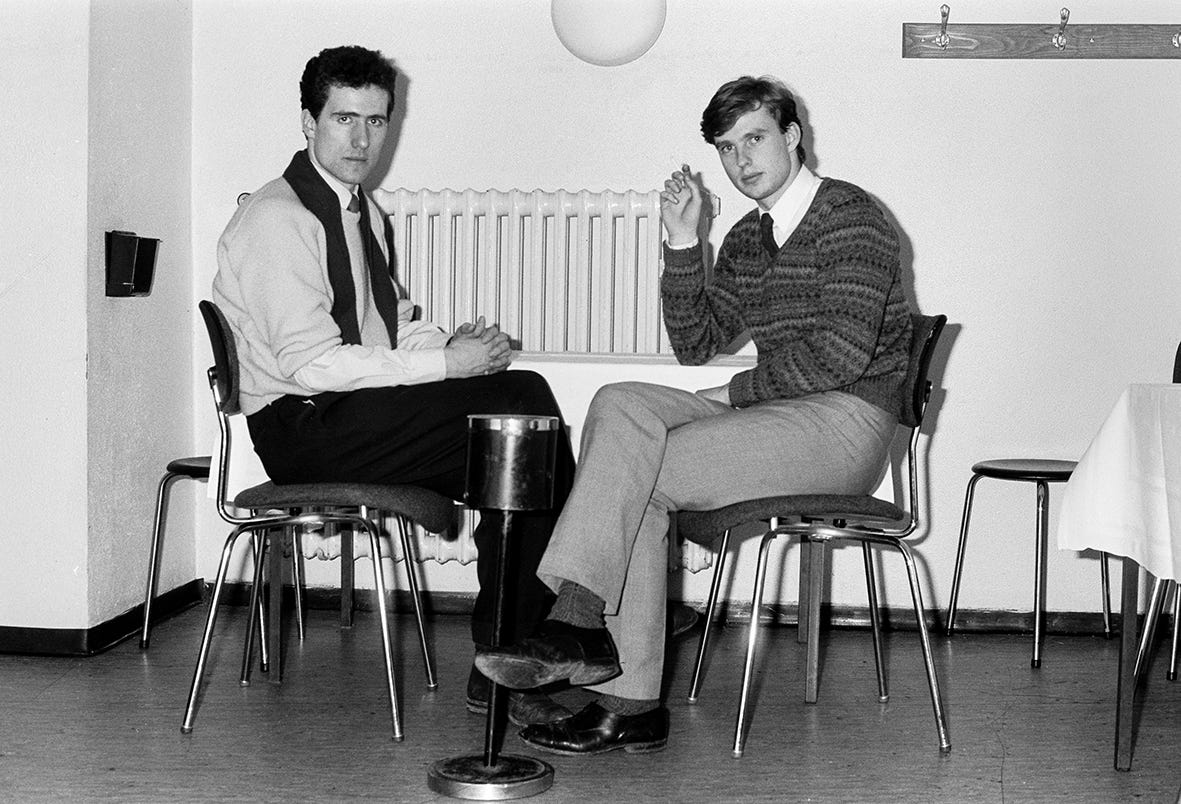New Wave in Germany: Elaste 1980–1986
A new coffee-table book tells the story of the award-winning culture magazine
In the mid-1980s, three young DJs, photographers and designers were running a music and culture magazine out of their shared Munich apartment. After work they’d go out to the clubs to spin records.
They’d go for a meal with Andy Warhol one day, and have whiskey with Jello Biafra of The Dead Kennedys the next. They’d meet people like John Lydon and Pedro Almodóvar, David Bowie and Robert Smith, Keith Haring and Klaus Nomi, Kraftwerk and Depeche Mode.
Their magazine Elaste, which existed from 1980 to 1986, covered an exciting period in music, fashion, arts and culture. Punk was over, pop was the new avant-garde. It was the era of the New Romantics, of gender non-conforming pop stars and the rise of electronic music.
Without the support of a traditional publisher, Elaste still had high-end, often self-shot photography, big name artist interviews, and glossy fashion editorials. The magazine won several design awards and was internationally known and revered. Artists soon asked their PR reps to get them featured in the German magazine. Some outstanding photographers and writers got their start at Elaste.
A new 560-page coffee-table book published by co-founders Thomas Elsner and Michael Reinboth looks back at the magazine history, compiling original photos, articles and new fore- and afterwords. While Elsner is still a creative director in the fashion magazine world, Reinboth has been running his successful independent label Compost Records for more than 30 years.
I caught up with two thirds of the original Elaste crew on a Zoom conference call.
You founded Elaste in 1980 – in Hanover, Germany, of all places. Paint the picture for me please.
Michael Reinboth: At the time, Hanover had a vibrant local punk scene, and we were quite involved in that. Around ‘77, ‘78, I used to hang out at this small bar, Die Rote Kuh (‘the red cow’). There was this other club, more of a disco spot, which played a lot of Bowie, Roxy Music and the likes. And then a new club opened, Basement, which was different. All of a sudden, disco was over, and a new aesthetic took its place, all grey concrete and neon lights. That was when the ‘80s really started for me, this change to the New Wave look. I started DJing at Basement, and Thomas at another club, Casablanca. Our first office was at Thomas’ loft. I lived right around the corner. We started Elaste at his kitchen table.
Thomas Elsner: Hanover was much more punk than Munich, where we moved together in ‘82. Christian, the third member of our original editorial team, was already studying photography in Munich. He found an apartment for us, so we went down there together one day and started running the magazine out of this place. We just saw more opportunities there in terms of concerts, exhibitions and potential partners for the magazine as well.
Did other, similar magazines exist at the time in Germany?
Michael Reinboth: Spex started in the same year as Elaste, in 1980. They were very focused on music though, just like Sounds, who were still around as well. With Thomas and Christian, we had two photographers and graphic designers in our original team, so we wanted to cover fashion and photography as well. I was responsible for the journalistic part. In the first three issues, I wrote a lot of articles myself. Later we had two full-time editors and a bunch of freelance writers – some of them would become quite famous, like Giovanni di Lorenzo [editor-in-chief of Die Zeit, Germany’s most renowned weekly newspaper|, [author] Maxim Biller, [author and academic] Diedrich Diederichsen, [author, musician and DJ] Thomas Meinecke, and others.
This was the time of pre-digital, all-analog publishing. What made you think you could just do it yourself, without the money and resources of a big publisher?
Michael Reinboth: That came through the music. Most musicians we knew just pressed their own vinyls and distributed them directly. They recorded runs of a couple of hundred tapes and just brought them to the record shops all by themselves. That whole punk and DIY movement shaped us and our attitude towards running the magazine.
Thomas Elsner: The punk idea was that everyone could form a band. You didn’t even need to know how to play an instrument, you just needed to do it. You could now record at home, with a drum machine and a synthesizer. Everyone just did stuff, there wasn’t so much strategy behind it. The younger generation carved out its own lane, independent of big labels and companies. We decided to go down the same route.
Michael Reinboth: Today, you have social media and crowdfunding. We didn’t even have a fax machine in our office! No email or cellphones either. If you wanted to reach someone, you’d need to send them a letter or call them on a landline. All the punk zines were xeroxed by hand. Our articles were written out on a typewriter, so you couldn’t make a mistake because in that case, you’d need to start over on a new page. Thomas built the layout physically, on a big desk, piecing the articles and images together, and then we’d take those page proofs to the printing plant.
We even distributed the magazine ourselves at the beginning. So we loaded up the trunk of the car, and then we went to Düsseldorf, to Berlin, to Hamburg, to Munich – just to seek out the cool stores. That way, we met loads of people, and those connections would become important for the magazine. Later we got an actual distributor, but suddenly we had to change our format, because it was too large for the standard newspaper kiosks at the main train stations. We hadn’t even thought about that.
Part of the allure was that the makers and writers of the magazine weren’t journalists looking into a scene from the outside, but you could feel they were actually part of it.
Thomas Elsner: Yeah, exactly. It wasn’t just some magazine for young people, it was actually made by young people. We wanted to showcase the scene around us. We often invited artists and designers whose work we loved to contribute to Elaste. We allowed them to get creative with their input, so they might tell us how they want their page layout to look, or we’d just give an artist carte blanche to do whatever they want on a full or a double page spread.
Michael Reinboth: There was a huge diversity in topics and opinions as well. The tone of voice went from serious to playful to dadaistic. Each issue had bits of fashion, literature, music, cartoons, design, architecture.. the full spectrum.
That elasticity is reflected in the title, of course.
Thomas Elsner: Right. We often used our friends instead of actual models in the magazine, because we thought many of them looked cool, and they were dressing in an interesting style. We also had a gossip column and nightlife pictures, so when a new issue was out, everyone in the scene always checked if they were in the magazine. It wasn’t even so much about the 15 minutes of fame that Andy Warhol had talked about; it was more about being seen, feeling represented.
How political was Elaste?
Michael Reinboth: We were left-leaning but not overly political. We had some writers whose articles often had some political twist or undertones, but I’d say that was mostly happening between the lines.
I’m asking because the early New Wave scene was often accused of being too superficial, too polite, too affirmative, and too white.
Thomas Elsner: Well, even back then, people were accusing us of betraying the values of punk, and bullshit like that. We were just in tune with the zeitgeist, which was driven by visual aesthetics. For us, it was about a combination of pleasing aesthetics with the right content. I still believe both are important to push culture forward. I’d actually say we were pioneers in that regard.
You’d have to admit that the scene was pretty white though. There simply weren’t that many people of colour around. Though we had quite a few Black friends and from the very early issues made sure they were represented in the magazine as well.
In the early to mid-1980s, that masculine rock energy made way for gay, queer and gender-expansive artists, and you did cover that movement in Elaste.
Michael Reinboth: Well, when I was much younger, back in the 1970s, I had this friend in London, and he’d take me out to these legendary gay clubs. They always had amazing music and a great atmosphere. Later, when I worked as a DJ in clubs myself, it was just normal to me to be around a mix of creative people from different scenes and cultures, and I think we brought that openness to the magazine.
Thomas Elsner: Again, it was part of the zeitgeist as well. Remember ‘84, there was so much going on: Bronski Beat. Queen with “I Want To Break Free”. The Pet Shop Boys. The Smiths. This, and so much more, all happened within 12 months.
What’s astonishing to me is how you got all those big international artists to agree to interviews in Elaste.
Thomas Elsner: As soon as we had a couple of issues out, it became much easier because we had something to show for. For example, [the late Austrian pop star] Falco had seen the magazine somewhere and loved it, so he told his record company to reach out because he wanted to speak to us. Artists and their label reps were actually calling us up asking, “What do I have to do to get in your magazine?”
Michael Reinboth: I was working as a music journalist for other magazines as well, so I already had contacts into the industry. After the third issue, all the record companies started calling us up and offering interviews with their artists. That was one of the reasons why we’d gone to Munich, after all. Often we’d just go backstage after concerts to meet the artists and hang out. Sometimes we’d show them around the city and the clubs. As soon as we had a couple of big names in there, it was much easier to get the next ones. It was generally easier in those days to get in contact with artists.
Thomas Elsner: I remember when Jello Biafra, singer of The Dead Kennedys, asked me where he’d get a good whiskey in Munich. I was like, I have no idea, but let’s just go to this bar, Schumann’s, that we regularly frequented at the time. So that’s what we did, and the whiskey turned out to be very much to his liking.
Was the scene in Munich very different from Hanover?
Michael Reinboth: Well, in Munich, there was just so much more going on in the arts and film and culture, and at a much bigger scale too. Elaste had grown as well – each issue had more pages than the last one. I couldn’t write all of the articles anymore, as I’d done in the beginning. So we got two full-time editors to support us.
Thomas Elsner: Another huge difference was that we all lived together in an apartment which doubled as our shared office. In a way, it brought us closer together, but maybe it also separated us in the end. I don’t know. It was almost like some of these rock bands who lived together in these communes in the 1970s, like Faust…
…or Ton Steine Scherben, who moved out of Berlin to a rural farm in Northern Germany.
Thomas Elsner: Exactly. We shared everything – cooked food together, ate meals together, and created a magazine together. We got to know each other really well. The magazine got an even stronger identity in Munich. But there were other forces at play, new people coming in, girlfriends moving in. We were all constantly around each other, and that led to certain arguments, or maybe it didn’t but it should have...
Michael Reinboth: But in the end, it was a lack of funding that ended the whole project. We never earned any money with Elaste. At our high point, we had a print run of 15,000 copies. But we needed to pay the printing in advance. So we all worked and earned money as DJs, graphic designers or photographers. Otherwise it wouldn’t have been possible. Sometimes we got people to help us out with advance loans, or ad clients would pay upfront. But it got increasingly difficult with time, to a point where it just didn’t feel feasible to continue.
In 1986, when you stopped, New Wave was over, and the reign of acid house started. Two years later, the summer of love was in full effect.
Michael Reinboth: Sure, but even before that – I don’t know, the whole pop thing had just become too big. Suddenly Madonna was a superstar, and MTV became so huge and turned the whole scene into this mass culture. Then, of course, the big publishing houses entered the market and founded new magazines, spending a lot of money to pay the best writers and photographers. For us, it was mortifying. We were pretty demotivated.
Thomas Elsner: We were simply growing older as well. The times had changed, the music had changed, we had changed. It was time to move on. Some of our editors left, and our third co-founder, Christian, went off to Paris and then New York. I started working as an art director for Condé Nast, and had less time to invest in the magazine.
Michael Reinboth: Looking at this thick book, I’m pretty proud of what we achieved though. This was still a divided country, the Berlin Wall was still standing. I think this book is an important document of youth culture in the BRD (Bundesrepublik Deutschland, the official abbreviation of the state of West Germany until 1989). It was a ridiculous effort, but a beautiful time. I wouldn’t want to miss a day.
Order the book ELASTE (1980-86) (in German & English)







I love the idea of finding whisky for Jello Biafra!
Thank you Stephan for this brilliant article — it instantly pulled me back into the raw, analog energy of the 80s, when subculture wasn’t curated but lived. Pure Love!!